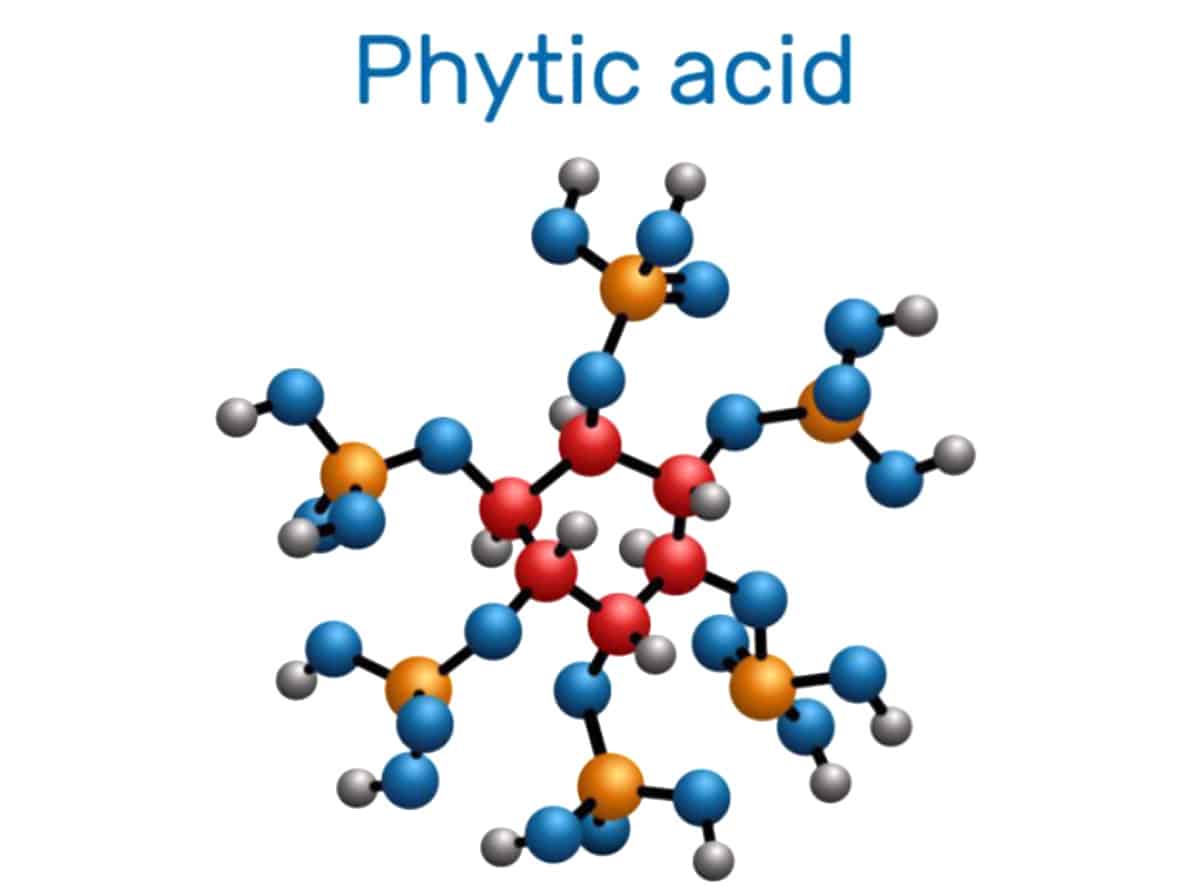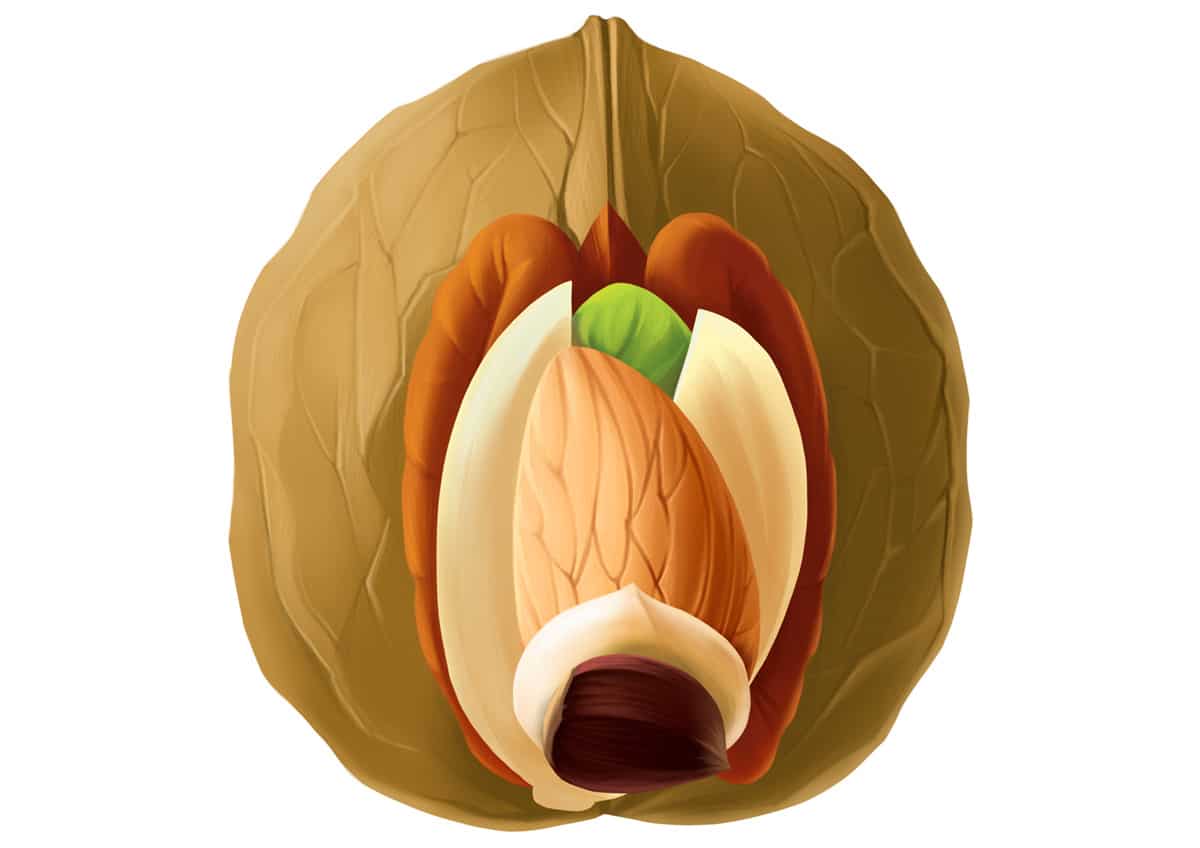
Phytic acid is generally considered an "antinutrient," and it's one of the big reasons why Paleo excludes grains and legumes…but it’s more complicated than you might think. For example, did you know that it actually has some health benefits? Did you know that some Paleo foods actually have more phytic acid by weight than grains and legumes?
Once you carefully look at the evidence, this doesn’t actually change the Paleo recommendation to avoid grains and legumes – but it’s a perfect example of why nutrition isn’t black and white. Dividing foods or nutrients into “good” and “bad” categories with no middle ground is easy, but it’s not scientific, and it makes your nutritional choices hard to defend.
What Is Phytic Acid?
Phytic acid, or phytate, is a chemical compound found in all plant foods, mostly in the seeds of plant foods. Basically, it binds to minerals and helps store them for the seed to use as food later. The minerals most affected are iron, zinc, magnesium, and calcium. When the seed germinates, the sprout can use those minerals to grow.
That’s great for the plant, but unfortunately you are not a plant, and you can’t use minerals that have been bound to phytic acid. So even if a plant has a high amount of (say) calcium, if all that calcium is bound up with phytic acid, the calcium won’t actually be available to your body to break down and use (to build up your bones and teeth, restore minerals lost in sweat, regulate cardiac function, etc. etc.) So you’ll get less calcium from that food than the number on the Nutrition Facts panel suggests (You’d think this would be adjusted for in the nutritional information, but it’s not)
On top of reducing mineral absorption, phytic acid also reduces the production of digestive enzymes. This can make foods containing phytic acid harder to digest, especially for people who have trouble producing enough digestive enzymes in the first place.
So far, it’s looking pretty bleak. But take a look at the flip side.
Benefits of Phytic Acid
They exist! First, the rat studies:
- Because of the way it binds to calcium, phytic acid can help prevent the formation of kidney stones.
- Also because of its bonds to calcium, phytic acid might improve heart health by preventing calcium deposits in the arteries.
- In another study, a diet supplemented with phytic acid helped to prevent fatty liver by changing gene expression and modifying the gut bacteria.
- One last rat study: phytic acid improved gut health and reduced inflammation in rats fed a junk-food diet.
In humans, phytic acid in foods reduces the blood sugar spike in response to those foods. Phytic acid is also an antioxidant and in particular it helps prevent the oxidation of iron.
It’s not black and white. Phytic acid really represents a nutrient with both good and bad properties. The benefits come packaged together with the downsides. This study is the perfect example: a new strain of rice has a reasonable antioxidant content (from phytic acid), but at the cost of mineral bioavailability (because of phytic acid).
This isn’t a black-and-white problem – it’s a tricky question of finding a middle ground between extremes. The Paleo food template is an attempt to find that middle ground, but to understand how it works, it helps to take a look at how phytic acid comes packed in actual food.
Phytic Acid In Foods
Here’s a table showing the amount of phytic acid in different foods. (source is this study). The table gives the phytic acid in grams per 100 grams of the food, plus a rough estimation of how much “100 grams” of that food looks like in measurements that you actually use.
| Category | Food | Phytic acid, in grams per 100 grams dry weight | Roughly what 100 grams looks like |
| Grains | Corn | 0.72-2.22 | ⅔ cup |
| Maize germ | 6.39 | ||
| Wheat | 0.39-1.35 | ⅔ cup | |
| Wheat bran | 2.1-7.3 | ||
| Wheat germ | 1.14-3.91 | ||
| Rice | 0.06-1.08 | ½ cup | |
| Rice bran | 2.56-8.7 | ||
| Wild rice | 2.2 | ⅔ cup | |
| Barley | 0.38-1.16 | ½ cup | |
| Oats | 0.42-1.16 | ¾ cup | |
| Rye | 0.54-1.46 | ⅔ cup | |
| Legumes | Kidney beans | 0.61-2.38 | ½ cup |
| Broad beans | 0.51-1.77 | ½ cup | |
| Peas | 0.22-1.22 | ½ cup | |
| Chickpeas | 0.28-1.60 | ½ cup | |
| Lentils | 0.27-1.51 | ½ cup | |
| Peanuts | 0.17-4.47 | ⅔ cup | |
| Nuts | Almonds | 0.35-9.42 | ⅔ cup |
| Walnuts | 0.2-6.69 | ⅔ cup | |
| Cashews | 0.19-4.98 | ⅔ cup | |
| Brazil nuts | 0.29-6.34 | ⅔ cup | |
| Pistachios | 0.29-2.83 | ⅔ cup | |
| Hazelnuts | 0.23-0.92 | ⅔ cup | |
| Macadamia nuts | 0.15-2.62 | ⅔ cup | |
| Pecans | 0.18-4.52 | ⅔ cup | |
| Pine nuts | 0.2 | ⅔ cup |
A few points to notice:
- There’s huge variation within each food. For example, wheat could have as little as 0.39 grams of phytic acid or as much as 1.35 grams per 100 grams of wheat (about ⅔ cup). The high value is over 3 times the amount of the low value! That’s like saying that the weight of an adult human is typically between 100 and 300 pounds – sure, it’s true, but it really makes a big difference where on that spectrum you fall.
- On average, nuts actually have much more phytic acid than either grains or legumes. Take a look at those high values. 9.42 grams for almonds? 6.69 for walnuts? Ouch! So if you’re wondering at this point why nuts are even considered Paleo, keep reading because that’s a question that really does need to be addressed.
Paleo includes nuts, but excludes grains and legumes. Now let’s take a look at why, and how that helps you get the benefits of phytic acid but without the downsides.
Phytic Acid and Paleo
Paleo is really the best of all possible worlds: it lets you avoid phytic acid with no negative consequences if you need to completely eliminate it, but also lets you consume a little bit if you're OK with it, without jeopardizing your nutrient intake. Paleo eliminates staple foods high in phytic acid, but includes nuts as an optional “extra” or “pleasure” food that isn’t a

major source of any important nutrients. People who can’t handle any phytic acid can just avoid nuts without missing any nutrients, and people who can handle phytic acid can get it occasionally from nuts without jeopardizing their primary source of nutrition. It’s basically a flexible template that lets you choose your own level of phytic acid exposure.
Almost all the studies showing the dangers of phytic acid in humans were done on people eating staple foods rich in phytic acid. People who eat the bulk of their calories from grains and don’t get a lot of animal foods have nutrient deficiency problems from phytic acid. This is quite common in the developing world, but not so much in the US. By Paleo standards, foods high in phytic acid shouldn’t be staple foods, because they cause obvious problems for human health that totally outweigh any potential antioxidant benefits they might have.
If you were only judging by phytic acid without considering any other factors, grains might be OK on Paleo in small doses. But of course, there are lots of other factors that take grains off the plate. On the other hand, for nuts, there isn’t any decisive factor that would argue for eliminating them completely. (Unless you have a nut allergy, but that’s a personal issue and doesn’t apply to people without allergies). Even the Omega-6 fats aren’t dangerous in small doses.
On Paleo, nuts aren’t a staple food, and you're not relying on them as a source of iron, calcium, or any other nutrients. So the phytic acid they contain isn't jeopardizing your nutrition. On the other hand, Paleo also has plenty of other antioxidants and plenty of other foods that are good for blood sugar control, so if you can't handle phytic acid, it's not a crisis:
- If you have weak digestion, skip them: you don’t need another food suppressing your production of digestive enzymes. Nuts are notoriously hard to digest, and phytic acid might be one reason why.
- If you have serious mineral deficiencies, skip them.
- If you don’t have any digestive problems with nuts, and you don’t have anemia or any other mineral deficiencies, nuts in small doses are fine. You can get the antioxidant and other benefits of phytic acid, without jeopardizing and important source of nutrients in your diet, because you were never relying on nuts for iron or calcium anyway. You have steak and green vegetables for that!
As a side note, if you do have to compromise on Paleo (no judgement! Life isn’t always smooth sailing!), there are ways to minimize phytic acid even in grains and legumes. Soak them before cooking, and cook them for as long as you can – it’s not ideal, but it’s better than nothing.
Summing it Up
Phytic acid isn’t a nutrient that you can shove in a box and classify as “good” or “bad.” It has some good properties, and it has some bad properties.
Staple foods rich in phytic acid, like grains and legumes, probably aren’t right for most people. And grains and legumes have problems besides phytic acid anyway. But in the Paleo template, nuts give you the chance to either remove phytic acid completely (if you need to) or leave a little bit of it in, in a way that doesn’t jeopardize your major nutrient sources. It’s a flexible template that leaves room for individual people to do what works best for them – there’s no one-size-fits-all in nutrition.





Leave a Reply